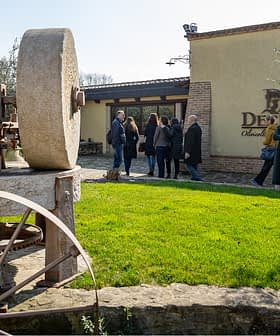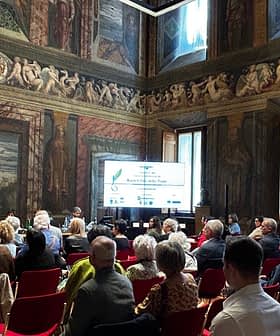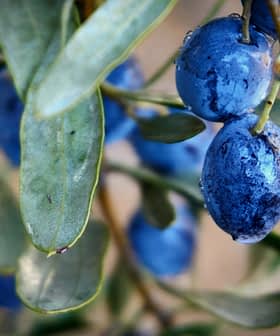The Gethsemane and Its Sacred Olive Oil
In Jerusalem last Thursday, like every year, the extra virgin olive oil produced from the olive trees of Gethsemane was blessed at the Holy Sepulcher.
 A view from Gethsemane:
A view from Gethsemane: 7K reads
7K readsThe Garden of Gethsemane is a small grove consisting of eight ancient olive trees located at the foot of the Mount of Olives just outside the Old City of Jerusalem. Its name derives from the Aramaic word gat semãnê, which means ‘olive press’ and suggests the presence of a mill in ancient times.
To know that these olive trees were present at the Passion of Our Lord Jesus Christ, to be here now and see that they still bear fruits is an incredible feeling.
This piece of land is famous because, according to the Gospels written by Matthew and Mark, here is where after the Last Supper Jesus retired with His disciples to pray, when He was betrayed by Judas and arrested by soldiers and Pharisees.
The Gospels and other sacred texts, confirmed by archeological finds, are considered reliable sources on the life of Jesus, who is the founder of Christianity but is praised and respected also by other religions. The Agony He suffered during the last night of His life at Gethsemane gave this place a deep spiritual significance which reaches its peak during Easter celebrations.
The Holy Week has just ended when we talked with the 44-year-old Italian Franciscan friar Father Diego Dalla Gassa, who is in charge of the Hermitage of Gethsemane, to learn more about these special olive trees.
“The Custody of the Holy Land followed the research activities carried out in the olive grove during a study realized by experts in biology and plant physiology from Italian universities and the National Research Council,” he explained. The project coordinated by Giovanni Gianfrate and Antonio Cimato, aimed at evaluating the state of preservation of the olive trees, showing that the portion of them which is currently visible dates back to the mid-12th century.
“But certainly, the original part of the plants is much older,” Fra Diego said. “We well know that it is difficult to determine the exact age of secular olive trees due to the deterioration of the most ancient section of the trunk. The CNR estimated that the aerial part of the trees is relatively young, probably due to actions taken by the Crusaders, when they arrived in Jerusalem, to preserve them better.”
The actual level of the soil is higher than that at the time, due to stratified deposits over the ages. “Analysis on root-core samples showed not only that the olive trees belong to a unique original variety, but also that, extraordinarily, all of them have the same DNA which means that certainly they were propagated by cuttings from a mother plant,” Fra Diego revealed.

Believers in prayer at Gethsemane on Holy Thursday
We know that after 70 A.D., which is the date of the destruction of the Temple at Jerusalem, and in 130 A.D., the olive trees probably suffered from ravages and fires fomented by the emperor Hadrian and his troops, which would not have destroyed them completely as the older part of them has been preserved.
“The olive tree is effectively considered a symbol of eternal life,” Fra Diego observed. “The fact that these plants were propagated by cuttings indicates that, most probably, the Christian custodians who later kept the Garden opted intentionally for this solution: They wanted to preserve the genetic heritage of the olive trees which had witnessed the Agony of Jesus.”
We do not know which the mother plant is, but it is not excluded that these olive trees have been planted more than two-thousand years ago. “To know that these olive trees were present at the Passion of Our Lord Jesus Christ, to be here now and see that they still bear fruits is an incredible feeling,” the Custodian affirmed.
Further analysis showed that the plants are healthy and free from any diseases. The olive fruit fly does not proliferate thanks to the high temperatures recorded during summer and, in general, the ideal microclimate of the area makes the work of the custodians easier. Even the researchers called “a small miracle” the fact that the soil of Gethsemane seems able to prevent the growth of harmful bacteria and pathogens.

Harvest at Gethsemane
The Franciscan Friars of the Custody, mostly Italians, take care of the olive trees with the support of experts. Pruning is performed every year by one or two people, and the branches are cut delicately based on a training system not intended to increase the production, but to maintain a shape which aesthetically fits into the context of a sacred garden.
The olive grove is managed with great care in such a way to ensure nothing disrupts the healthy growth of the plants, which do not need any particular phytosanitary treatment thanks to their excellent condition.
“Last time I took care of the harvest we collected about 700 kilograms (1,543 pounds) of olives,” Fra Diego revealed, explaining that during harvest time they gather a group of no more than 20 volunteers and, if it is good weather, they start harvesting on the second Saturday in October.

Fra Diego Dalla Gassa harvesting at Gethsemane (Photos by Ylenia Granitto for Olive Oil Times)
“We need a week to conclude harvesting operations because we generally we work on maximum two trees a day,” he added. Then, the olives are brought to a local mill where operators take special precautions. The Franciscan friars also help supervise the neighboring Kidron valley.
While the production of the surrounding groves is used for the maintenance of their convents, the extra virgin olive oil obtained from the olive trees of the Sacred Garden is used exclusively for liturgical purposes; that is why every year on Holy Thursday it is blessed during the Chrism Mass celebrated at the Holy Sepulcher. After Easter, the oil is sent to the parishes of the territory, where it will be used for sacraments throughout the year.
Nothing is wasted, and with the collaboration of local families, pits are used to create rosaries which will be given to friars on the day for consecrated life, February 2nd, together with a thumb-sized bottle of oil.
On Holy Thursday, again this year, the sacred oil was blessed and the olive trees of Gethsemane were surrounded by prayers and emotions.








